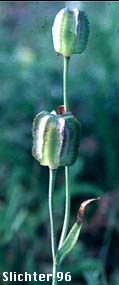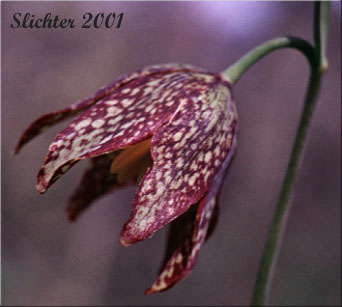 The
photo at right is of a chocolate lily from the Memaloose area of the central
Columbia River Gorge of Oregon............April 15, 2001.
The
photo at right is of a chocolate lily from the Memaloose area of the central
Columbia River Gorge of Oregon............April 15, 2001.Chocolate lily is also known as mission bells. Chocolate lilies are attractive wildflowers with slender to stout stems rising from 15-100 cm. One or two whorls of 3-5 leaves are found scattered along the stem. Individual leaves range from linear to lanceolate or ovate-lanceolate in shape, and each ranges from 3-25 mm wide and 5-15 cm long. The bulbs have many fleshy scales and small bulblets.
The flowers are occasionally solitary or more commonly number 2 to 5. They are pendent while the broadly winged seed capsule becomes erect. The six tepals are oblong-lanceolate to oblong in shape and range from 20-30 mm long. They are broader at the base and taper gradually to the tip. The anthers are 4-5 mm long with the slender filaments 2-3 times longer. The seed capsules are typically about 2 cm long.
Chocolate lilies make great wildflowers for the woodland or prairie garden. From seed, they take a number of years before flowering the first time. Plants collected from the wild often don't survive. However, many wildflower nurseries carry this attractive plant at reasonable prices.
Chocolate lilies may be found on grassy bluffs, on prairies, and in open oak woods and coniferous forests. from near sea level to above 5000'.
Chocolate lilies may be found from southern British Columbia south along both sides of the Cascade Mts. of Washington to the Columbia River Gorge. In Oregon, it may be found wholly west of the Cascades (except one siting in the Blue Mts.) to southern California. In Washington it is found eastward to northern Idaho.

